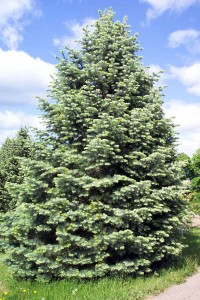Concolor Fir (White Fir)
The concolor fir is a species of coniferous trees found in the western parts of North America at an altitude of 3,000-11,200 ft (900-3,400 m). Its small, needle-like leaves occurring in rows are usually flat and are without stalks. The leaves at the apex are curvier and thicker than the leaves below.
The young trees have smooth, gray, thin barks with conspicuous resin-bearing pockets. However, as they grow old, the trunks become thick, light gray or reddish-brown in color, and have deep furrows with flattened ridges.
Scientific Classification
| Kingdom | Plantae |
| Division | Pinophyta |
| Class | Pinopsida |
| Order | Pinales |
| Family | Pinaceae |
| Genus | Abies |
| Scientific Name | Abies concolor |
Subspecies
- Abies concolor concolor (Rocky Mountains white fir or Colorado white fir)
- Abies concolor lowiana (Sierra Nevada white fir or Low’s white fir)
Quick Information
| Other Names | White Fir |
| Closely related to | Mexican fir, Durango fir, grand fir |
| Size | Medium to large trees with a height of 60-200 ft (18-61 m) and a trunk diameter measuring about 6.6 ft (2 m) |
| Leaves (Needles) | 2-3 inches long, 2 mm wide, 0.5-1 mm thick; silvery-blue/silvery-green in color |
| Cones (Strobili) | 6-12 cm long, 4-4.5 cm wide; olive green when young but turn into purple and finally pale brown with age; have short scale bracts with around 100-150 scales |
| Tree Type | Evergreen |
| Shape at Maturity | Pyramidal with the lower branches having a drooping appearance |
| Distribution/Range | Subsp. concolor: Rocky Mountains, Utah, Colorado, New Mexico, Arizona, Great Basin, and southeastern California in the US as well as northern Sonora in Mexico Subsp. lowiana: Cascades, Oregon, Sierra Nevada, and Klamath Mountains in the US; northern Baja California in Mexico |
| Hardiness Zones | 3-7 |
| Lifespan | In the landscape it has a life expectancy of 50 years while in the forest it can survive up to 300 years |
| Growth Rate | Slow to medium; its height usually increases by 1-2 feet every year but sometimes it can be slower than the normal growth rate |
| Growing Conditions | Humidity: Moderate to high humidity Winter Conditions: Long winters, moderate/heavy snowfall needed. Can survive in temperatures as low as -40°C. Rain: Annual precipitation of 35-75 inches Sunlight: Direct sunlight (for at least 4 hours) as well as partial shade Soil Requirements: Well-drained moist, sandy, acidic, and loamy soils; moderately resistant to heat and drought |
| Pests and Diseases | Concolor firs are susceptible to needle rusts, heart rot fungi and attacks from pests like bark beetles, Douglas-fir tussock moth, and spruce budworm; affected by the parasitic plant mistletoe and pollutants like sulfur dioxide |
| Flowering Time | May-June |
| Dispersal of Seeds | September-October |
| Seeds borne at | 40 years of age |
| Seed Bearing Frequency | Every 2-4 years |
| Wildlife Value | These are good roosting places for game birds, which sometimes feed on the needles and buds of the white fir; rodents, squirrels, crossbills, chickadees, and nutcrackers are often seen eating the seeds; the seedlings, needles, and buds are also eaten by deer |
| Landscape cultivars | Blue Cloak, Candicans, Compacta, Gable’s Weeping, Winter Gold, Conica |
| Uses |
|
| IUCN Conservation Status | Least Concern |
Interesting Facts
- The concolor fir was first found by William Lobb during 1849-1853 when he was on his way to explore California.
- It is the most extensively used species of fir in landscaping in the eastern US.
- The concolor firs have a shallow and widespread root system, which makes them vulnerable to “windthrow”. Therefore, buffer strips (strips of permanent vegetation) are left against the wind through careful selective cuttings to reduce erosion.
References
- https://en.wikipedia.org/wiki/Abies_concolor
- https://realchristmastrees.org/education/tree-varieties/concolor-fir-white-fir/
- https://plants.sc.egov.usda.gov/DocumentLibrary/factsheet/pdf/fs_abco.pdf
- https://www.canr.msu.edu/hrt/uploads/535/78626/concolor-fir-w-cover.pdf
- https://www.arborday.org/Trees/TreeGuide/TreeDetail.cfm?ItemID=839







